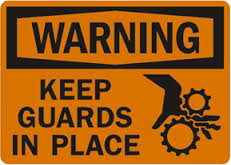Moving machine parts have the potential for causing severe workplace injuries, such as crushed fingers or hands, amputations, burns, and blindness, just to name a few. Also machine guarding and related machinery violations continuously rank among the top 20 of OSHA citations issued. Here are the top 4 issues we find in the field:
#1 Missing Machine Guard
1910.212(a)(1) General requirements for all machines—Machine guarding. Types of guarding—One or more methods of machine guarding shall be provided to protect the operator and other employees in the machine area from hazards such as those created by point of operation, ingoing nip points, rotating parts, flying chips and sparks.
#2 Bench Grinder Tongue Guard out of Adjustment
1910.215(b)(9) Guarding of abrasive wheel machinery. The peripheral protecting member (guard) shall be provided and adjusted within 1⁄4 inch of the wheel to contain and deflect fragments away from the operator.
#3 Bench Grinder Work Rest out of Adjustment
1910.215(a)(4) Abrasive wheel machinery—General requirements. Work rests—on offhand grinding machines, work rests shall be used to support the work.… Work rests shall be kept adjusted closely to the wheel with a maximum opening of 1⁄8 inch to prevent work from being jammed between wheel and rest.…
#4 Point of Operation Machine Guarding
1910.212(a)(3) General requirements for all machines—Machine guarding. Point of operation of machines whose operation exposes an employee to injury shall be guarded.… Special hand tools for placing and removing material shall permit easy handling of material without the operator placing a hand in the danger zone.
In general any machine part, function, or process that might cause injury must be safeguarded. When the operation of a machine or accidental contact with it could injure the operator or others in the vicinity, the hazards must be either controlled or eliminated.
Here are some general requirements and suggestions for Safeguards:
- Prevent contact: The safeguard must prevent hands, arms, and any other part of an operator’s body from making contact with dangerous moving parts. A good safeguarding system eliminates the possibility of the operator or another worker placing parts of their bodies near hazardous moving parts.
- Secure: Operators should not be able to easily remove or tamper with the safeguard, because a safeguard that can easily be made ineffective is no safeguard at all. Guards and safety devices should be made of durable material that will withstand the conditions of normal use. They must be firmly secured to the machine.
- Protect from falling objects: The safeguard should ensure that no objects can fall into moving parts. A small tool dropped into a cycling machine could easily become a projectile that could strike and injure someone.
- Create no new hazards: A safeguard defeats its own purpose if it creates a hazard such as a shear point, a jagged edge, or an unfinished surface that could cause a laceration. The edges of guards, for instance, should be rolled or bolted in such a way to eliminate sharp edges.
- Create no interference: Any safeguard that impedes an operator from performing the job quickly and comfortably might soon be overridden or disregarded. Proper safeguarding may actually enhance efficiency since it relieves the operator’s apprehensions about injury.
- Allow safe lubrication: If possible, workers should be able to lubricate the machine without removing the safeguards. Locating oil reservoirs outside the guard, with a line leading to the lubrication point, will reduce the need for the operator or maintenance operator to enter the hazardous area.
Keep in mind that guards are engineering controls which eliminate the hazard at the source and do not rely on the operator’s behavior for their effectiveness. With that said even the most elaborate safeguarding system cannot offer effective protection unless the operator knows how to use it and why. Specific and detailed training is therefore a crucial part of any effort to provide safeguarding against machine-related hazards.
If you would like to arrange a machine guarding assessment of your facility contact Randy Free. 407-353-8165 or email him at rfree[at]safetylinks.net
